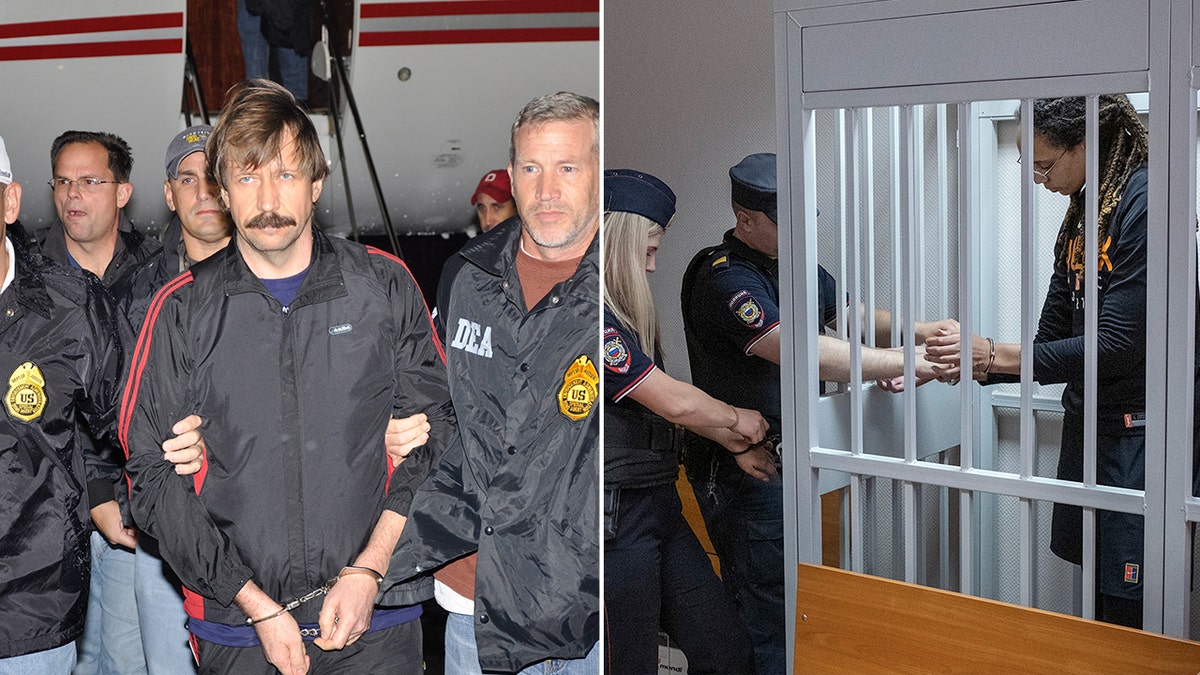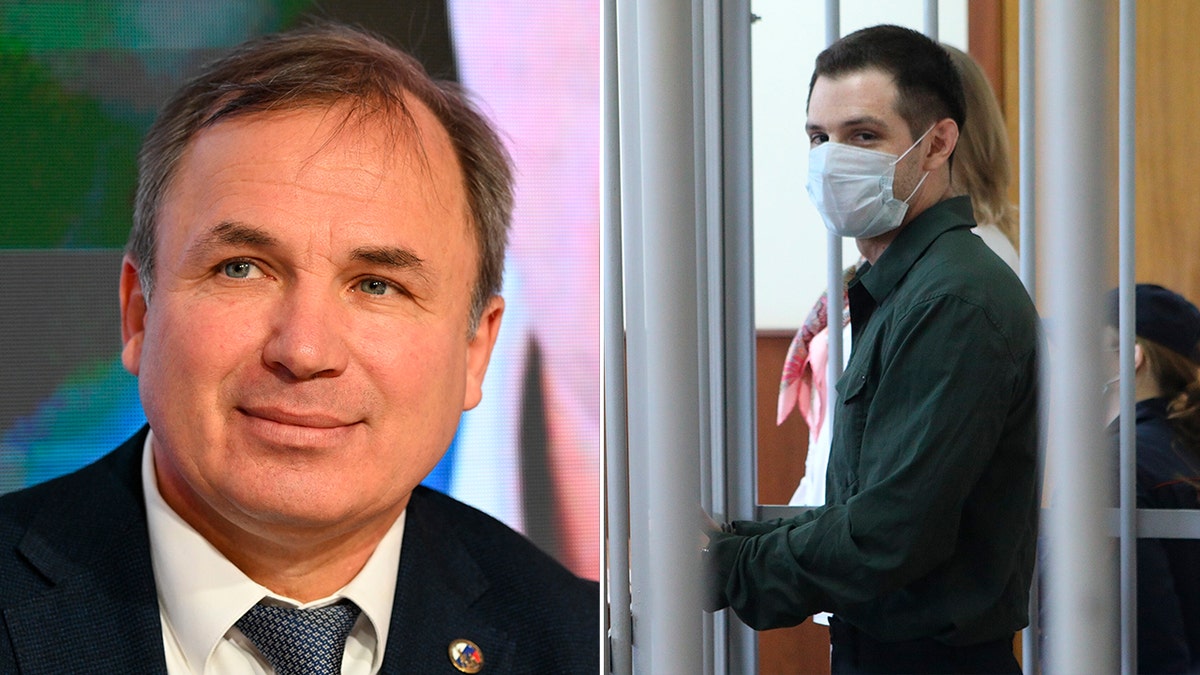Wall Street Journal newsroom staff cheer Gershkovich's release
Staff at the Wall Street Journal, Evan Gershkovich's employer, react to news of their colleague having been released from a Russia prison after he was arrested and detained more than a year ago. (Credit: Vaughn Sterling/The Wall Street Journal)
Three American citizens and one American green-card holder were released from Russian custody on Thursday as part of a massive swap of political prisoners involving the United States and Russia.
Wall Street Journal reporter Evan Gershkovich, former U.S. Marine Paul Whelan and fellow American Alsu Kurmasheva were among those released as well as Vladimir Kara-Murza. The multinational exchange is the biggest U.S.-Russia prisoner swap since the Cold War.
President Biden called the prisoner swap deal with Russia a "feat of diplomacy."
There have been a number of other U.S.-Russia prisoner swaps over the years. Here's a look back at seven major prisoner exchanges and the details surrounding them.
December 2022
Prior to Aug. 1, 2024, the last major prisoner exchange took place on Dec. 8, 2022, when WNBA star Brittney Griner was swapped for convicted Russian arms dealer Viktor Bout, the "Merchant of Death," as Fox News Digital reported at the time.
Griner, who had been playing basketball in Russia during the off-season, was arrested by Russian authorities on Feb. 17, 2022, after less than a gram of hash oil was found in her luggage. She pleaded guilty and was sentenced to nine years in prison.

Russian arms dealer Viktor Bout, left, was released from U.S. custody in exchange for WNBA star Brittney Griner, right, who had been sentenced to nine years in a Russian prison after her arrest in 2022. (U.S. Department of Justice via Getty Images; The Washington Post via Getty Images)
Bout was arrested in Thailand in 2008 and extradited to the U.S., where he was convicted of terrorism-related charges and sentenced to 25 years in prison in 2012.
The exchange took place at Al Bateen Executive Airport in Abu Dhabi, United Arab Emirates, as Reuters and others reported.
April 2022
Earlier that same year, U.S. Marine veteran Trevor Reed was released from Russian custody on April 27, 2022, in exchange for Konstantin Yaroshenko.
AMERICAN CULTURE QUIZ: TEST YOURSELF ON VICTORIOUS VEEPS, BRONX BOMBERS AND BIRTH OF BURGERS
Reed was arrested in Russia in 2019, accused of attacking a police officer, and was later sentenced to nine years in prison, as Fox News Digital reported earlier.
Reed's family maintained his innocence and the U.S. government described him as unjustly detained.

Russian pilot Konstantin Yaroshenko, left, was swapped for U.S. Marine veteran Trevor Reed, right, pictured in a Russian courtroom in 2020. (Pavel Bednyakov/host photo agency Sputnik via AP; Andrei Nikerichev/Moscow News Agency via AP)
His release was brokered as part of a one-for-one prisoner exchange for Yaroshenko, a Russian pilot who was sentenced to 20 years in a U.S. prison for smuggling cocaine into the country, Reuters reported.
July 2010
Ten Russian sleeper agents detained in the U.S. as part of the so-called "Illegals Program" were exchanged for four prisoners held in Russia.
One of the freed Russian prisoners was Sergei Skripal, who was convicted of high treason for working as a double agent for the United Kingdom, Reuters said.
The swap took place on July 9, 2010, on the tarmac at Vienna International Airport in Austria.
September 1986
The second of two prisoner exchanges in the year 1986 came after U.S. News & World Report correspondent Nicholas Daniloff was arrested on Sept. 2 and accused of espionage by the KGB.
Daniloff, who claimed he had been framed, was held for less than a month before he was allowed to leave the Soviet Union on Sept. 23 without facing charges.
The U.S. believed Daniloff's arrest was in retaliation for the recent capture of Gennadi Zakharov, a Soviet citizen employed at the United Nations in New York City.

The United Nations headquarters in New York City. The U.S. believed Daniloff's arrest was in retaliation for the capture of Gennadi Zakharov, a Soviet citizen who was employed at the United Nations. (iStock)
Zakharov pleaded no contest and was allowed to leave the U.S.
Also released was Soviet dissident Yuri Orlov, chairman of the Moscow Helsinki Group who spent nine years in prison and internal exile for documenting his country's violations of the human rights provisions of the Helsinki accords, according to Reuters.
February 1986
Natan Sharansky was the first political prisoner released by then-Soviet leader Mikhail Gorbachev on Feb. 11, 1986.
Sharansky was accused of being a U.S. spy. He spent nine years in prison.
CLICK HERE TO GET THE FOX NEWS APP
He and three low-level Western spies were swapped for Czech spies Karl Koecher and wife Hana Koecher, who had been arrested two years earlier in New York City, along with Soviet bloc spies Yevgeni Zemlyakov, Marian Zacharski and Detlef Scharfenorth, held in West Germany, said Reuters.
June 1985
Polish former intelligence officer Marian Zacharski was swapped alongside three other Soviet agents in exchange for 23 Americans held for espionage in Eastern Europe on June 12, 1985.
Zacharaski was arrested in 1981 and convicted of espionage.
CLICK HERE TO SIGN UP FOR OUR LIFESTYLE NEWSLETTER
The swap took place after three years of negotiations, Reuters noted.
February 1962
The first major prisoner swap between the U.S. and the Soviet Union is commonly known as the "Bridge of Spies" exchange.

The Glienicke Bridge was the site of the first major U.S.-Soviet Union prisoner exchange. (Soeren Stache/picture alliance via Getty Images)
Convicted Soviet spy Rudolf Abel was swapped for American pilot Francis Gary Powers on the Glienicke Bridge on Feb. 10, 1962.
For more Lifestyle articles, visit www.foxnews.com/lifestyle
The bridge formed the border between West Berlin and East Germany.
Reuters contributed reporting to this article.


